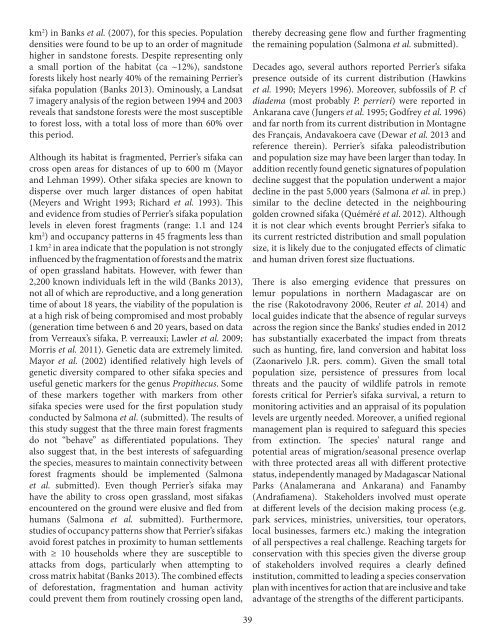Primates in Peril
f12q6x
f12q6x
You also want an ePaper? Increase the reach of your titles
YUMPU automatically turns print PDFs into web optimized ePapers that Google loves.
km 2 ) <strong>in</strong> Banks et al. (2007), for this species. Population<br />
densities were found to be up to an order of magnitude<br />
higher <strong>in</strong> sandstone forests. Despite represent<strong>in</strong>g only<br />
a small portion of the habitat (ca ~12%), sandstone<br />
forests likely host nearly 40% of the rema<strong>in</strong><strong>in</strong>g Perrier’s<br />
sifaka population (Banks 2013). Om<strong>in</strong>ously, a Landsat<br />
7 imagery analysis of the region between 1994 and 2003<br />
reveals that sandstone forests were the most susceptible<br />
to forest loss, with a total loss of more than 60% over<br />
this period.<br />
Although its habitat is fragmented, Perrier’s sifaka can<br />
cross open areas for distances of up to 600 m (Mayor<br />
and Lehman 1999). Other sifaka species are known to<br />
disperse over much larger distances of open habitat<br />
(Meyers and Wright 1993; Richard et al. 1993). This<br />
and evidence from studies of Perrier’s sifaka population<br />
levels <strong>in</strong> eleven forest fragments (range: 1.1 and 124<br />
km 2 ) and occupancy patterns <strong>in</strong> 45 fragments less than<br />
1 km 2 <strong>in</strong> area <strong>in</strong>dicate that the population is not strongly<br />
<strong>in</strong>fluenced by the fragmentation of forests and the matrix<br />
of open grassland habitats. However, with fewer than<br />
2,200 known <strong>in</strong>dividuals left <strong>in</strong> the wild (Banks 2013),<br />
not all of which are reproductive, and a long generation<br />
time of about 18 years, the viability of the population is<br />
at a high risk of be<strong>in</strong>g compromised and most probably<br />
(generation time between 6 and 20 years, based on data<br />
from Verreaux’s sifaka, P. verreauxi; Lawler et al. 2009;<br />
Morris et al. 2011). Genetic data are extremely limited.<br />
Mayor et al. (2002) identified relatively high levels of<br />
genetic diversity compared to other sifaka species and<br />
useful genetic markers for the genus Propithecus. Some<br />
of these markers together with markers from other<br />
sifaka species were used for the first population study<br />
conducted by Salmona et al. (submitted). The results of<br />
this study suggest that the three ma<strong>in</strong> forest fragments<br />
do not “behave” as differentiated populations. They<br />
also suggest that, <strong>in</strong> the best <strong>in</strong>terests of safeguard<strong>in</strong>g<br />
the species, measures to ma<strong>in</strong>ta<strong>in</strong> connectivity between<br />
forest fragments should be implemented (Salmona<br />
et al. submitted). Even though Perrier’s sifaka may<br />
have the ability to cross open grassland, most sifakas<br />
encountered on the ground were elusive and fled from<br />
humans (Salmona et al. submitted). Furthermore,<br />
studies of occupancy patterns show that Perrier’s sifakas<br />
avoid forest patches <strong>in</strong> proximity to human settlements<br />
with ≥ 10 households where they are susceptible to<br />
attacks from dogs, particularly when attempt<strong>in</strong>g to<br />
cross matrix habitat (Banks 2013). The comb<strong>in</strong>ed effects<br />
of deforestation, fragmentation and human activity<br />
could prevent them from rout<strong>in</strong>ely cross<strong>in</strong>g open land,<br />
thereby decreas<strong>in</strong>g gene flow and further fragment<strong>in</strong>g<br />
the rema<strong>in</strong><strong>in</strong>g population (Salmona et al. submitted).<br />
Decades ago, several authors reported Perrier’s sifaka<br />
presence outside of its current distribution (Hawk<strong>in</strong>s<br />
et al. 1990; Meyers 1996). Moreover, subfossils of P. cf<br />
diadema (most probably P. perrieri) were reported <strong>in</strong><br />
Ankarana cave (Jungers et al. 1995; Godfrey et al. 1996)<br />
and far north from its current distribution <strong>in</strong> Montagne<br />
des Français, Andavakoera cave (Dewar et al. 2013 and<br />
reference there<strong>in</strong>). Perrier’s sifaka paleodistribution<br />
and population size may have been larger than today. In<br />
addition recently found genetic signatures of population<br />
decl<strong>in</strong>e suggest that the population underwent a major<br />
decl<strong>in</strong>e <strong>in</strong> the past 5,000 years (Salmona et al. <strong>in</strong> prep.)<br />
similar to the decl<strong>in</strong>e detected <strong>in</strong> the neighbour<strong>in</strong>g<br />
golden crowned sifaka (Quéméré et al. 2012). Although<br />
it is not clear which events brought Perrier’s sifaka to<br />
its current restricted distribution and small population<br />
size, it is likely due to the conjugated effects of climatic<br />
and human driven forest size fluctuations.<br />
There is also emerg<strong>in</strong>g evidence that pressures on<br />
lemur populations <strong>in</strong> northern Madagascar are on<br />
the rise (Rakotodravony 2006, Reuter et al. 2014) and<br />
local guides <strong>in</strong>dicate that the absence of regular surveys<br />
across the region s<strong>in</strong>ce the Banks’ studies ended <strong>in</strong> 2012<br />
has substantially exacerbated the impact from threats<br />
such as hunt<strong>in</strong>g, fire, land conversion and habitat loss<br />
(Zaonarivelo J.R. pers. comm). Given the small total<br />
population size, persistence of pressures from local<br />
threats and the paucity of wildlife patrols <strong>in</strong> remote<br />
forests critical for Perrier’s sifaka survival, a return to<br />
monitor<strong>in</strong>g activities and an appraisal of its population<br />
levels are urgently needed. Moreover, a unified regional<br />
management plan is required to safeguard this species<br />
from ext<strong>in</strong>ction. The species’ natural range and<br />
potential areas of migration/seasonal presence overlap<br />
with three protected areas all with different protective<br />
status, <strong>in</strong>dependently managed by Madagascar National<br />
Parks (Analamerana and Ankarana) and Fanamby<br />
(Andrafiamena). Stakeholders <strong>in</strong>volved must operate<br />
at different levels of the decision mak<strong>in</strong>g process (e.g.<br />
park services, m<strong>in</strong>istries, universities, tour operators,<br />
local bus<strong>in</strong>esses, farmers etc.) mak<strong>in</strong>g the <strong>in</strong>tegration<br />
of all perspectives a real challenge. Reach<strong>in</strong>g targets for<br />
conservation with this species given the diverse group<br />
of stakeholders <strong>in</strong>volved requires a clearly def<strong>in</strong>ed<br />
<strong>in</strong>stitution, committed to lead<strong>in</strong>g a species conservation<br />
plan with <strong>in</strong>centives for action that are <strong>in</strong>clusive and take<br />
advantage of the strengths of the different participants.<br />
39


